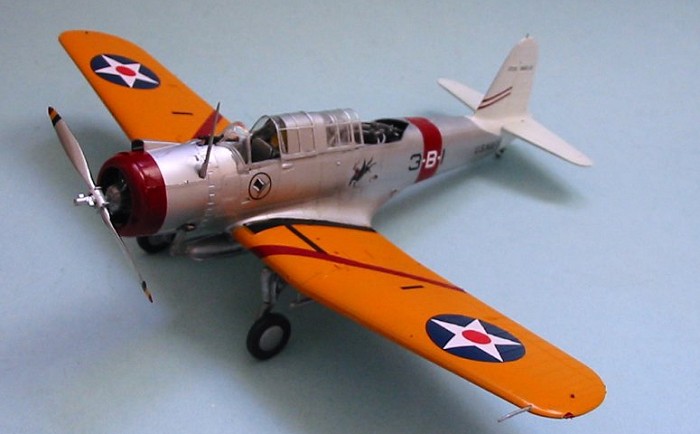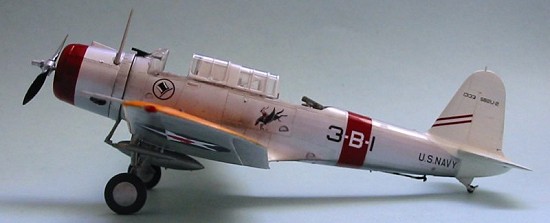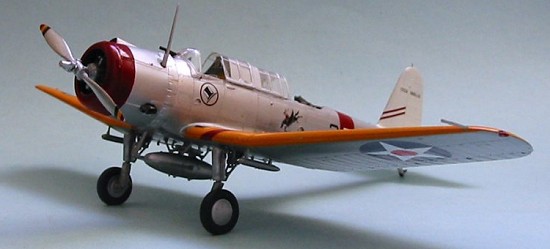
| KIT: | Accurate Miniatures 1/48 SB2U-1 Vindicator |
| KIT #: | ? |
| PRICE: | $34.95 MSRP |
| DECALS: | 1 option |
| REVIEWER: | Tom Cleaver |
| NOTES: | Yellow Wings decals used. |

| HISTORY |
With the rapid development in aeronautical technology in the 1930s, it was the quite often the case that an airplane that did represent the state of the art when it appeared in the middle years of that decade was obsolescent if not obsolete by the time the war came and the airplane faced the uncompromising crucible of combat.
So it was with the U.S. Navy’s first monoplane dive bomber, the Vought SB2U “Vindicator.” Flown in combat twice - by French aircrews in the Battle of France in May and June 1940, and by U.S. Marines at the Battle of Midway in June 1942, the Vindicator proved itself anything but a suitable machine with which to fight a modern war. While it offered structural integrity and a thoroughly reliable powerplant, it had been hopelessly outmoded by advances in technology since its birth eight years earlier. Its shortcomings were many: the fuel tanks were highly vulnerable to enemy fire and its defensive armament was minimal, while its performance with a useful warload fell sadly short of what was needed. It possessed barely-adequate lateral control and at normal loaded weight its maneuverability was sluggish.
 The SB2U-1 was
Chance-Vought’s answer to a requirement put forward by the Bureau of
Aeronautics in 1934 for a two-seat scout and dive-bomber. The
specification called for a substantial performance advance over existing
aircraft in this category, though it did not call for a monoplane per
se. Rex Beisel’s design resulted in a contract for a prototype, the
XSB2U-1, on October 11, 1934, produced in competition with the Brewster
XSBA-1. While a monoplane with retractable landing gear and enclosed
cockpits, structurally, the design was conservative, using the construction
methodology of contemporary biplanes. The forward fuselage and wing center
section was metal-skinned, as were the horizontal and vertical stabilizers,
but the rear fuselage, outer wings aft of the main spar and all control
surfaces were fabric-covered.
The SB2U-1 was
Chance-Vought’s answer to a requirement put forward by the Bureau of
Aeronautics in 1934 for a two-seat scout and dive-bomber. The
specification called for a substantial performance advance over existing
aircraft in this category, though it did not call for a monoplane per
se. Rex Beisel’s design resulted in a contract for a prototype, the
XSB2U-1, on October 11, 1934, produced in competition with the Brewster
XSBA-1. While a monoplane with retractable landing gear and enclosed
cockpits, structurally, the design was conservative, using the construction
methodology of contemporary biplanes. The forward fuselage and wing center
section was metal-skinned, as were the horizontal and vertical stabilizers,
but the rear fuselage, outer wings aft of the main spar and all control
surfaces were fabric-covered.
The XSB2U-1 first flew on January 4, 1936. After preliminary contractor’s tests were completed, it was delivered to the Navy at NAS Anacostia on July 2, 1936. The Navy’s evaluation suffered a setback when the prototype crashed near Norfolk on August 20, 1936. Fortunately, testing was sufficiently advanced for the Navy to proceed with ordering 54 SB2U-1s on October 26.
The SB2U-1 differed from the XSB2U-1 with strengthened cockpit framing, repositioning of the radio mast, addition of a substantial carburetor intake, and use of the R-1535-96 Twin Wasp, which provided a useful increase in power to 825 h.p. on takeoff and 750 h.p. at 9,000 feet, raising maximum speed by 20 mph at all altitudes. Range with a 500-lb bomb in scouting configuration was 699 miles, while use of a 1,000-lb bomb in the dive-bombing role reduced range to 635 miles.
 Vought had
originally proposed to use a braking propeller to slow the dive speed and
maintain bombing accuracy, but this failed to work in practice and was
abandoned. Seven-finger “fences” above and below the outer wing on the
main spar were the next solution, but these produced excessive buffeting.
Eventually, the Navy was persuaded to accept shallower dive angles and the
expedient of extending the landing gear to provide sufficient braking in a
combat dive. The airplane was never really effective as a dive-bomber.
Vought had
originally proposed to use a braking propeller to slow the dive speed and
maintain bombing accuracy, but this failed to work in practice and was
abandoned. Seven-finger “fences” above and below the outer wing on the
main spar were the next solution, but these produced excessive buffeting.
Eventually, the Navy was persuaded to accept shallower dive angles and the
expedient of extending the landing gear to provide sufficient braking in a
combat dive. The airplane was never really effective as a dive-bomber.
This was ultimately fortunate for the Navy, inasmuch as it led them to contract with Northrop for another dive bomber that eventually emerged as the excellent SBD series, which was vastly superior to the SB2U. Had the Navy been forced to use SB2Us in the dive-bombing role during the crucial year of 1942, the history of the Pacific War might have been vastly different.
Four SB2U-1s were delivered to VB-3 “High Hats” on December 20, 1937. Five more arrived in January 1938, with an additional eight in February, and a final airplane on March 1, which gave the unit its full compliment of 18. The pilots had been flying the Curtiss BFC-2 single-seat biplane previously, and at first they did not like the comparatively-big SB2U-1 with all its modern “gadgets” like retractable gear, controllable prop, and enclosed canopy, not to mention its lack of maneuverability - they complained particularly about the heavy ailerons, poor roll rate and the sharp wing drop in a stall that could lead to a spin - in addition to uncompromising landing performance in comparison with the forgiving little Curtiss “Helldiver.”
The SB2U-1s were produced for VB-3 and VB-2. VB-2 - which had been flying the F4B-4 to this time - began taking delivery of their SB2U-1s in February 1938 and was fully equipped by April. Over the course of the year, the pilots came to understand their new mounts and accept them, developing new ways of using them as compared with the earlier biplanes.
 On January 20,
1938, the Navy ordered an additional 58 SB2U-2s - which were supposedly
different from the SB2U-1 only in some internal equipment - to equip VB-4
and later units being organized. The SB2U-2-equipped VB-4 swapped places
with the SB2U-1-equipped VB-3, with the units taking each other’s
designations and ship assignments. Eventually, as SB2U-2s were issued to
units flying the SB2U-1 as attrition replacements, it was discovered that
SB2U-1 outer wings could not be used on SB2U-2s, since the lower attachment
points were just different enough to not allow a solid lock. The remaining
SB2U-2s were sent to VS-72 when it went aboard the USS “Wasp” in 1940.
On January 20,
1938, the Navy ordered an additional 58 SB2U-2s - which were supposedly
different from the SB2U-1 only in some internal equipment - to equip VB-4
and later units being organized. The SB2U-2-equipped VB-4 swapped places
with the SB2U-1-equipped VB-3, with the units taking each other’s
designations and ship assignments. Eventually, as SB2U-2s were issued to
units flying the SB2U-1 as attrition replacements, it was discovered that
SB2U-1 outer wings could not be used on SB2U-2s, since the lower attachment
points were just different enough to not allow a solid lock. The remaining
SB2U-2s were sent to VS-72 when it went aboard the USS “Wasp” in 1940.
During 1940-41, SB2U-1s and SB2U-2s were used on the Neutrality Patrols, flying from the USS “Ranger” and the “Wasp.” VB-4 was redesignated VS-41 in March 1940, when VB-4 was re-equipped with the SBD “Dauntless.” VB-2 had given up their SB2Us for SBDs the previous month, and VB-3 would give up theirs in September - after the squadron’s airplanes starred in the movie “Dive Bomber,” shot at NAS North Island that summer.
| THE KIT |
 We all know
that, unfortunately, the first pressing of Accurate Miniature’s SB2U
Vindicators had “issues.” The mold sinks on the fuselage parts ranges from
mild to severe, and several modelers have reported short-shot clear parts.
As I hope I demonstrated with the Chesapeake and the SB2U-3 models, the
problems can be overcome. I personally had my doubts about successfully
doing a “Golden Wings” Vindicator, given that the fuselage in the area of
the sink marks is painted aluminum, and best done with a thin coat, making
things hard to hide. Linda Habovick, President of Accurate Miniatures,
provided me one of their “bad” pressings, to see if this version could be
done.
We all know
that, unfortunately, the first pressing of Accurate Miniature’s SB2U
Vindicators had “issues.” The mold sinks on the fuselage parts ranges from
mild to severe, and several modelers have reported short-shot clear parts.
As I hope I demonstrated with the Chesapeake and the SB2U-3 models, the
problems can be overcome. I personally had my doubts about successfully
doing a “Golden Wings” Vindicator, given that the fuselage in the area of
the sink marks is painted aluminum, and best done with a thin coat, making
things hard to hide. Linda Habovick, President of Accurate Miniatures,
provided me one of their “bad” pressings, to see if this version could be
done.
| CONSTRUCTION |
The big problem with this kit was to overcome the deep sink marks on the
fuselage halves. I filled these areas with cyanoacrylate glue, and let
them set up overnight to get a good hard set. Once that was done, I used a
new #11 X-acto
blade
to slice the glue down even with each of the facets of the fuselage area.
I then carefully filed these areas smooth, then
 polished
the whole part with
Tamiya plastic polish to create a uniform smooth surface and fill in any
small nicks left from the effort.
polished
the whole part with
Tamiya plastic polish to create a uniform smooth surface and fill in any
small nicks left from the effort.
Past that, the other big change with this model was to use the Falcon vacuformed canopy. This was actually made to fit the old HiPM kit, and is not an exact fit for the Accurate Miniatures kit if you wanted to attach it in the fully closed position. Additionally, the windscreen doesn’t fit at all. However, I was planning to pose the canopy open, so the fit problems would not be apparent. I used the kit windscreen, and cut open the greenhouse. Being vacuformed, it is nice and thin, and posing the sliding portions of the gunner’s canopy under the forward canopy was no problem, being merely a matter of trimming to the point it could slide under. I elected not to attach the canopy until after the model was painted.
Other than that, the kit went together with no problems not already noted in my earlier reviews.
| COLORS & MARKINGS |
Painting:
The Golden Wings scheme is complicated. I chose to do the squadron commander’s airplane from VB-3, as it appeared in the movie “Dive Bomber.”
First, I painted the tail, the nose, and the upper wings with Gunze-Sangyo gloss US Navy White, a color that is slightly “off-white” and not so bright, making it more realistic on the finished model.
 When that was
dry, I masked off the tail and then painted the upper wings with
Gunze-Sangyo “Orange-Yellow,” which is an exact match for the Navy “Chrome
Yellow” color as compared with the beautiful three-strip Technicolor shots
of the original airplane as viewed on my digitally-restored version of the
movie.
When that was
dry, I masked off the tail and then painted the upper wings with
Gunze-Sangyo “Orange-Yellow,” which is an exact match for the Navy “Chrome
Yellow” color as compared with the beautiful three-strip Technicolor shots
of the original airplane as viewed on my digitally-restored version of the
movie.
When that was dry, I masked off the wings, and shot the nose a slightly-darkened Gunze-Sangyo “Insignia Red” to match the color on the Yellow Wings decal sheet. When that was dry, it was time to go with the aluminum.
I used SNJ Aluminum overall as the first coat. This was masked off over the metal parts of the airframe to replicate the aluminum lacquer. I then shot the fabric areas with Testor’s Model Master Aluminum (non-buffing) which I covered with Testor’s Sealer, to replicate the aluminum dope on the original surfaces.
When all was dry, I unmasked and was ready for decals.
Decals:
The Yellow Wings decals go down with no problem. I used the kit decals for the national insignia.
| FINAL CONSTRUCTION |
 When the decals
were fully set, I washed off the model and then applied Xtracrylix Satin
Finish varnish over the nose, upper wings, tail and the decals on the
fuselage and lower wing. This gives a scale “glossy” finish. I then
attached the canopy in the open position and attached the landing gear,
drop tank and prop. Since U.S. Navy aircraft of this period were
maintained in immaculate condition, I did not apply any weathering to the
model.
When the decals
were fully set, I washed off the model and then applied Xtracrylix Satin
Finish varnish over the nose, upper wings, tail and the decals on the
fuselage and lower wing. This gives a scale “glossy” finish. I then
attached the canopy in the open position and attached the landing gear,
drop tank and prop. Since U.S. Navy aircraft of this period were
maintained in immaculate condition, I did not apply any weathering to the
model.
| CONCLUSIONS |
This kit is definitely the best SB2U Vindicator released by any company ever. It really isn’t any more difficult than the SBD Dauntless, and taming the dread “mold sinks” is easily done with some basic modeling ability
For anyone who enjoys carrier aircraft, and especially the carrier aircraft of the “Golden Wings Era,” this kit is a must-have.
October 2005
Review Kit Courtesy of Accurate Miniatures.
If you would like your product reviewed fairly and quickly by a site that has around 300,000 visitors a month, please contact me or see other details in the Note to Contributors.